Identification and Functional Characterization of Mutation in FYCO1 in Families with Congenital Cataract
Abstract
:1. Introduction
2. Materials and Methods
2.1. Population Recruitment
2.2. Molecular Studies
2.3. Bioinformatics Analysis of FYCO1 Mutations
2.3.1. Primary Sequence Analysis of FYCO1
Protein Order–Disorder Prediction
Analysis of Protein Conservation
Prediction of Physicochemical Properties of FYCO1
Prediction of the Secondary Structure of FYCO1
2.3.2. Tertiary Structure Prediction
2.3.3. Protein–Protein Interaction Analysis of FYCO1
2.3.4. Domain-Dependent Mutation Analysis of FYCO1
3. Results
3.1. Molecular Studies
3.2. Bioinformatics Analysis
3.2.1. Primary Structure Analysis of FYCO1
Prediction of FYCO1 Order/Disorder Patterns
Protein Conservation Analysis
Physicochemical Properties of FYCO1
Predicted Phosphorylation Sites of FYCO1
3.3. Prediction of the Three-Dimensional Structure of FYCO1
3.4. Analysis of Protein–Protein Interactions of FYCO1
3.5. Domain-Dependent Mutation Analysis of FYCO1
4. Discussion
5. Conclusions
Supplementary Materials
Author Contributions
Funding
Institutional Review Board Statement
Informed Consent Statement
Data Availability Statement
Acknowledgments
Conflicts of Interest
References
- Khokhar, S.K.; Pillay, G.; Dhull, C.; Agarwal, E.; Mahabir, M.; Aggarwal, P. Pediatric cataract. Indian J. Ophthalmol. 2017, 65, 1340–1349. [Google Scholar] [CrossRef] [PubMed]
- Wu, X.; Long, E.; Lin, H.; Liu, Y. Prevalence and epidemiological characteristics of congenital cataract: A systematic review and meta-analysis. Sci. Rep. 2016, 6, 28564. [Google Scholar] [CrossRef] [PubMed]
- Sheeladevi, S.; Lawrenson, J.G.; Fielder, A.R.; Suttle, C.M. Global prevalence of childhood cataract: A systematic review. Eye 2016, 30, 1160–1169. [Google Scholar] [CrossRef]
- Shiels, A.; Hejtmancik, J.F. Inherited cataracts: Genetic mechanisms and pathways new and old. Exp. Eye Res. 2021, 209, 108662. [Google Scholar] [CrossRef] [PubMed]
- Reis, L.M.; Semina, E.V. Genetic landscape of isolated pediatric cataracts: Extreme heterogeneity and variable inheritance patterns within genes. Hum. Genet. 2019, 138, 847–863. [Google Scholar] [CrossRef]
- Şekeroğlu, H.; Utine, G.E. Congenital Cataract and Its Genetics: The Era of Next-Generation Sequencing. Turk. J. Ophthalmol. 2021, 51, 107–113. [Google Scholar] [CrossRef]
- Shoshany, N.; Hejtmancik, F.; Shiels, A.; Datiles, M.B. Congenital and hereditary cataracts: Epidemiology and genetics. In Pediatric Cataract Surgery and IOL Implantation: A Case-Based Guide; Springer: Cham, Switzerland, 2020; pp. 3–23. [Google Scholar]
- Iqbal, H.; Khan, S.Y.; Zhou, L.; Irum, B.; Ali, M.; Ahmed, M.R.; Shahzad, M.; Ali, M.H.; Naeem, M.A.; Riazuddin, S.; et al. Mutations in FYCO1 identified in families with congenital cataracts. Mol. Vis. 2020, 26, 334–344. [Google Scholar]
- Dineen, B.; Bourne, R.R.; Jadoon, Z.; Shah, S.P.; Khan, M.A.; Foster, A.; Gilbert, C.E.; Khan, M.D.; Pakistan National Eye Survey Study Group. Causes of blindness and visual impairment in Pakistan. The Pakistan national blindness and visual impairment survey. Br. J. Ophthalmol. 2007, 91, 1005–1010. [Google Scholar] [CrossRef]
- Rahi, J.S.; Dezateux, C. Congenital and infantile cataract in the United Kingdom: Underlying or associated factors. British Congenital Cataract Interest Group. Invest. Ophthalmol. Vis. Sci. 2000, 41, 2108–2114. [Google Scholar]
- Wasnik, H.; Gandhi, R.; Patil, N.; Behera, R.; Golait, A.; Patel, T.; Baruah, T. A comprehensive review of molecular biology and genetics of cataract. Int. J. Res. Appl. Sci. Biotec. 2021, 8, 11–20. [Google Scholar] [CrossRef]
- Hansen, L.; Mikkelsen, A.; Nürnberg, P.; Nürnberg, G.; Anjum, I.; Eiberg, H.; Rosenberg, T. Comprehensive mutational screening in a cohort of Danish families with hereditary congenital cataract. Invest. Ophthalmol. Vis. Sci. 2009, 50, 3291–3303. [Google Scholar] [CrossRef]
- Al-Badran, R.A.; Al-Badran, A.I.; Mabudi, H.; Neissi, M.; Mohammadi-Asl, J. Detection of an FYCO1 nonsense mutation in an affected patient with autosomal recessive cataract (CTRCT18): A case report. Egyp. J. Med. Hum. Genet. 2022, 23, 52. [Google Scholar] [CrossRef]
- Saleem, R.S.; Siddiqui, S.N.; Irshad, S.; Ashraf, N.M.; Hamid, A.; Khan, M.A.U.; Khan, M.I.; Micheal, S. Targeted gene sequencing of FYCO1 identified a novel mutation in a Pakistani family for autosomal recessive congenital cataract. Mol. Genet. Genomic. Med. 2022, 10, e1985. [Google Scholar] [CrossRef] [PubMed]
- Barashkov, N.A.; Konovalov, F.A.; Borisova, T.V.; Teryutin, F.M.; Solovyev, A.V.; Pshennikova, V.G.; Sapojnikova, N.V.; Vychuzhina, L.S.; Romanov, G.P.; Gotovtsev, N.N.; et al. Autosomal recessive cataract (CTRCT18) in the Yakut population isolate of Eastern Siberia: A novel founder variant in the FYCO1 gene. Eur. J. Hum. Genet. 2021, 29, 965–976. [Google Scholar] [CrossRef] [PubMed]
- Chen, J.; Wang, Q.; Cabrera, P.E.; Zhong, Z.; Sun, W.; Jiao, X.; Chen, Y.; Govindarajan, G.; Naeem, M.A.; Khan, S.N.; et al. Molecular Genetic Analysis of Pakistani Families with Autosomal Recessive Congenital Cataracts by Homozygosity Screening. Invest. Ophthalmol. Vis. Sci. 2017, 58, 2207–2217. [Google Scholar] [CrossRef]
- Chen, J.; Ma, Z.; Jiao, X.; Fariss, R.; Kantorow, W.L.; Kantorow, M.; Pras, E.; Frydman, M.; Pras, E.; Riazuddin, S.; et al. Mutations in FYCO1 cause autosomal-recessive congenital cataracts. Am. J. Hum. Genet. 2011, 88, 827–838. [Google Scholar] [CrossRef]
- Li, J.; Chen, X.; Yan, Y.; Yao, K. Molecular genetics of congenital cataracts. Exp. Eye Res. 2020, 191, 107872. [Google Scholar] [CrossRef]
- Abouzeid, H.; Helmy, G.; El Sada, M.; Sherif, M.; Yacoub, M.H.; Boisset, G.; Favez, T.; Schorderet, D.F. FYCO1 mutation hotspot in congenital cataract. Invest. Ophthalmol. Vis. Sci. 2012, 53, 1723. [Google Scholar] [CrossRef]
- Nieto-Torres, J.L.; Shanahan, S.L.; Chassefeyre, R.; Chaiamarit, T.; Zaretski, S.; Landeras-Bueno, S.; Verhelle, A.; Encalada, S.E.; Hansen, M. LC3B phosphorylation regulates FYCO1 binding and directional transport of autophagosomes. Curr. Biol. 2021, 31, 3440–3449.e7. [Google Scholar] [CrossRef]
- Pankiv, S.; Alemu, E.A.; Brech, A.; Bruun, J.A.; Lamark, T.; Overvatn, A.; Bjørkøy, G.; Johansen, T. FYCO1 is a Rab7 effector that binds to LC3 and PI3P to mediate microtubule plus end-directed vesicle transport. J. Cell Biol. 2010, 188, 253–269. [Google Scholar] [CrossRef]
- Shakil, M.; Harlalka, G.V.; Ali, S.; Lin, S.; D’Atri, I.; Hussain, S.; Nasir, A.; Shahzad, M.A.; Ullah, M.I.; Self, J.E.; et al. Tyrosinase (TYR) gene sequencing and literature review reveals recurrent mutations and multiple population founder gene mutations as causative of oculocutaneous albinism (OCA) in Pakistani families. Eye 2019, 33, 1339–1346. [Google Scholar] [CrossRef] [PubMed]
- Kozlowski, L.P.; Bujnicki, J.M. MetaDisorder: A meta-server for the prediction of intrinsic disorder in proteins. BMC Bioinform. 2012, 13, 111. [Google Scholar] [CrossRef] [PubMed]
- Piovesan, D.; Tabaro, F.; Paladin, L.; Necci, M.; Micetic, I.; Camilloni, C.; Davey, N.; Dosztányi, Z.; Mészáros, B.; Monzon, A.M.; et al. MobiDB 3.0: More annotations for intrinsic disorder, conformational diversity and interactions in proteins. Nucleic Acids. Res. 2018, 46, D471–D476. [Google Scholar] [CrossRef] [PubMed]
- Xue, B.; Oldfield, C.J.; Dunker, A.K.; Uversky, V.N. CDF it all: Consensus prediction of intrinsically disordered proteins based on various cumulative distribution functions. FEBS. Lett. 2009, 583, 1469–1474. [Google Scholar] [CrossRef] [PubMed]
- Ashkenazy, H.; Abadi, S.; Martz, E.; Chay, O.; Mayrose, I.; Pupko, T.; Ben-Tal, N. ConSurf 2016: An improved methodology to estimate and visualize evolutionary conservation in macromolecules. Nucleic Acids. Res. 2016, 44, W344–W350. [Google Scholar] [CrossRef] [PubMed]
- Garnier, J.; Gibrat, J.F.; Robson, B. GOR method for predicting protein secondary structure from amino acid sequence. Methods Enzymol. 1996, 266, 540–553. [Google Scholar] [CrossRef] [PubMed]
- Cole, C.; Barber, J.D.; Barton, G.J. The Jpred 3 secondary structure prediction server. Nucleic Acids. Res. 2008, 36, W197–W201. [Google Scholar] [CrossRef]
- Du, Z.; Su, H.; Wang, W.; Ye, L.; Wei, H.; Peng, Z.; Anishchenko, I.; Baker, D.; Yang, J. The trRosetta server for fast and accurate protein structure prediction. Nat. Protoc. 2021, 16, 5634–5651. [Google Scholar] [CrossRef]
- Szklarczyk, D.; Morris, J.H.; Cook, H.; Kuhn, M.; Wyder, S.; Simonovic, M.; Santos, A.; Doncheva, N.T.; Roth, A.; Bork, P.; et al. The STRING database in 2017: Quality-controlled protein-protein association networks, made broadly accessible. Nucleic Acids. Res. 2017, 45, D362–D368. [Google Scholar] [CrossRef]
- Gillespie, R.L.; O’Sullivan, J.; Ashworth, J.; Bhaskar, S.; Williams, S.; Biswas, S.; Kehdi, E.; Ramsden, S.C.; Clayton-Smith, J.; Black, G.C.; et al. Personalized diagnosis and management of congenital cataract by next-generation sequencing. Ophthalmology 2014, 121, 2124–2137. [Google Scholar] [CrossRef]
- Marchler-Bauer, A.; Anderson, J.B.; Chitsaz, F.; Derbyshire, M.K.; DeWeese-Scott, C.; Fong, J.H.; Geer, L.Y.; Geer, R.C.; Gonzales, N.R.; Gwadz, M.; et al. CDD: Specific functional annotation with the Conserved Domain Database. Nucleic Acids. Res. 2009, 37, D205–D210. [Google Scholar] [CrossRef]
- Olsvik, H.L.; Lamark, T.; Takagi, K.; Larsen, K.B.; Evjen, G.; Øvervatn, A.; Mizushima, T.; Johansen, T. FYCO1 Contains a C-terminally Extended, LC3A/B-preferring LC3-interacting Region (LIR) Motif Required for Efficient Maturation of Autophagosomes during Basal Autophagy. J. Biol. Chem. 2015, 290, 29361–29374. [Google Scholar] [CrossRef]
- Johansen, T.; Lamark, T. Selective autophagy mediated by autophagic adapter proteins. Autophagy 2011, 7, 279–296. [Google Scholar] [CrossRef] [PubMed]
- Wang, Z.; Miao, G.; Xue, X.; Guo, X.; Yuan, C.; Wang, Z.; Zhang, G.; Chen, Y.; Feng, D.; Hu, J.; et al. The Vici Syndrome Protein EPG5 Is a Rab7 Effector that Determines the Fusion Specificity of Autophagosomes with Late Endosomes/Lysosomes. Mol. Cell 2016, 63, 781–795. [Google Scholar] [CrossRef]
- Suzuki, H.; Tabata, K.; Morita, E.; Kawasaki, M.; Kato, R.; Dobson, R.C.; Yoshimori, T.; Wakatsuki, S. Structural basis of the autophagy-related LC3/Atg13 LIR complex: Recognition and interaction mechanism. Structure 2014, 22, 47–58. [Google Scholar] [CrossRef]
- Yang, J.; Yan, R.; Roy, A.; Xu, D.; Poisson, J.; Zhang, Y. The I-TASSER Suite: Protein structure and function prediction. Nat. Methods 2015, 12, 7–8. [Google Scholar] [CrossRef]
- Morishita, H.; Mizushima, N. Autophagy in the lens. Exp. Eye Res. 2016, 144, 22–28. [Google Scholar] [CrossRef]
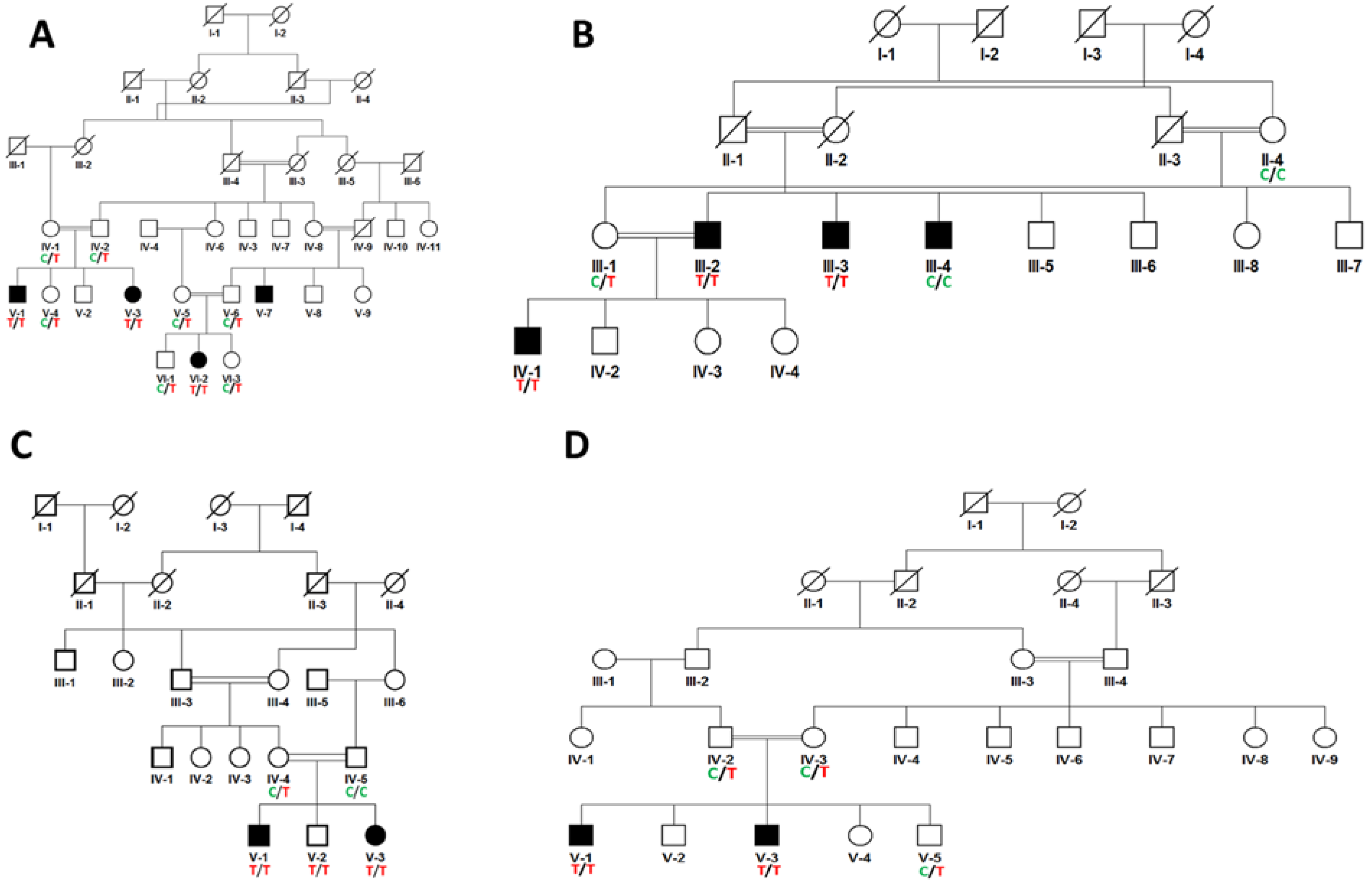

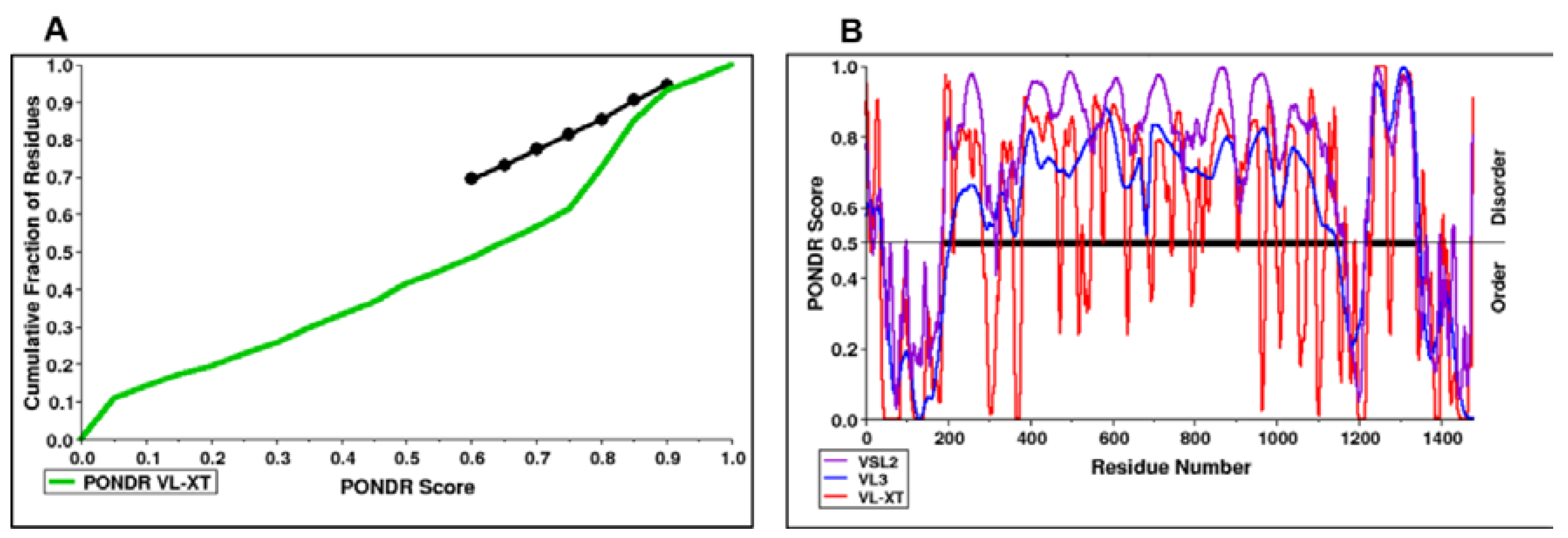
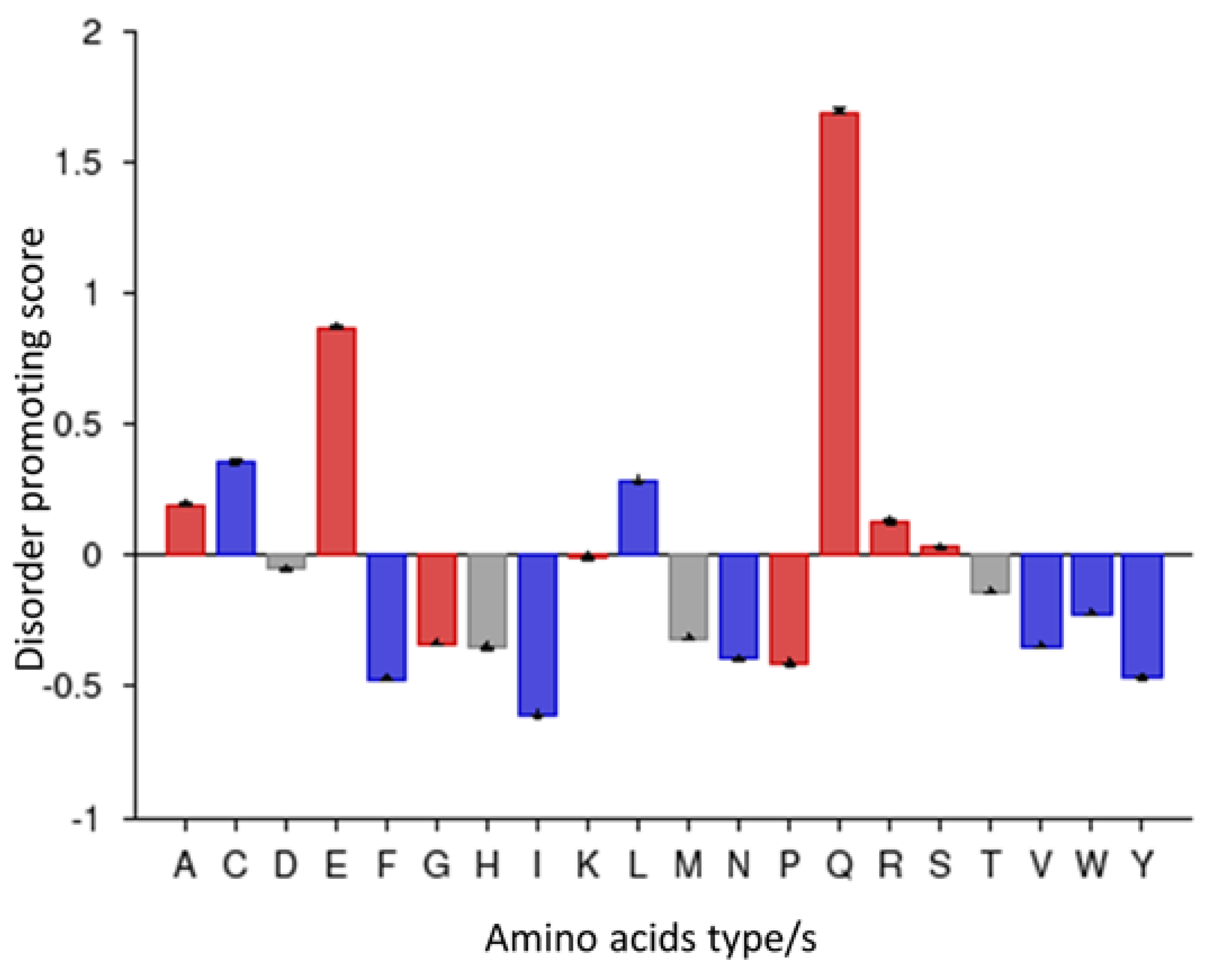
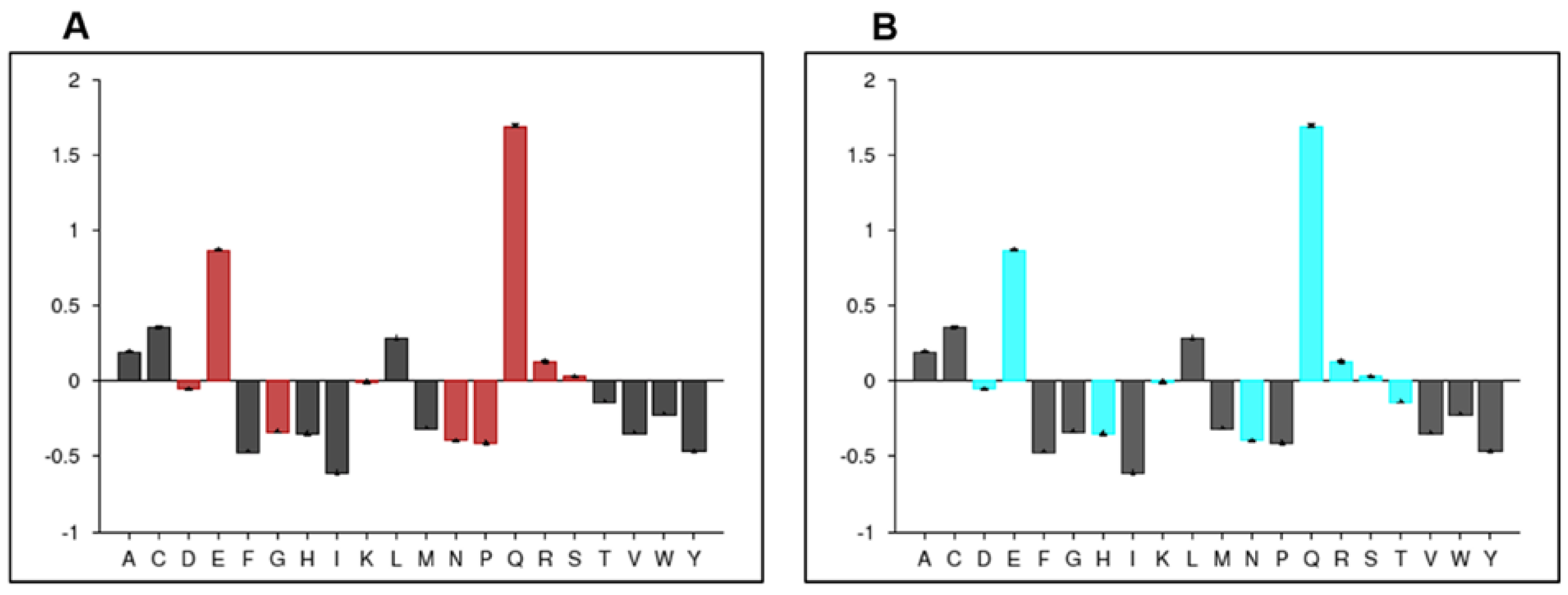
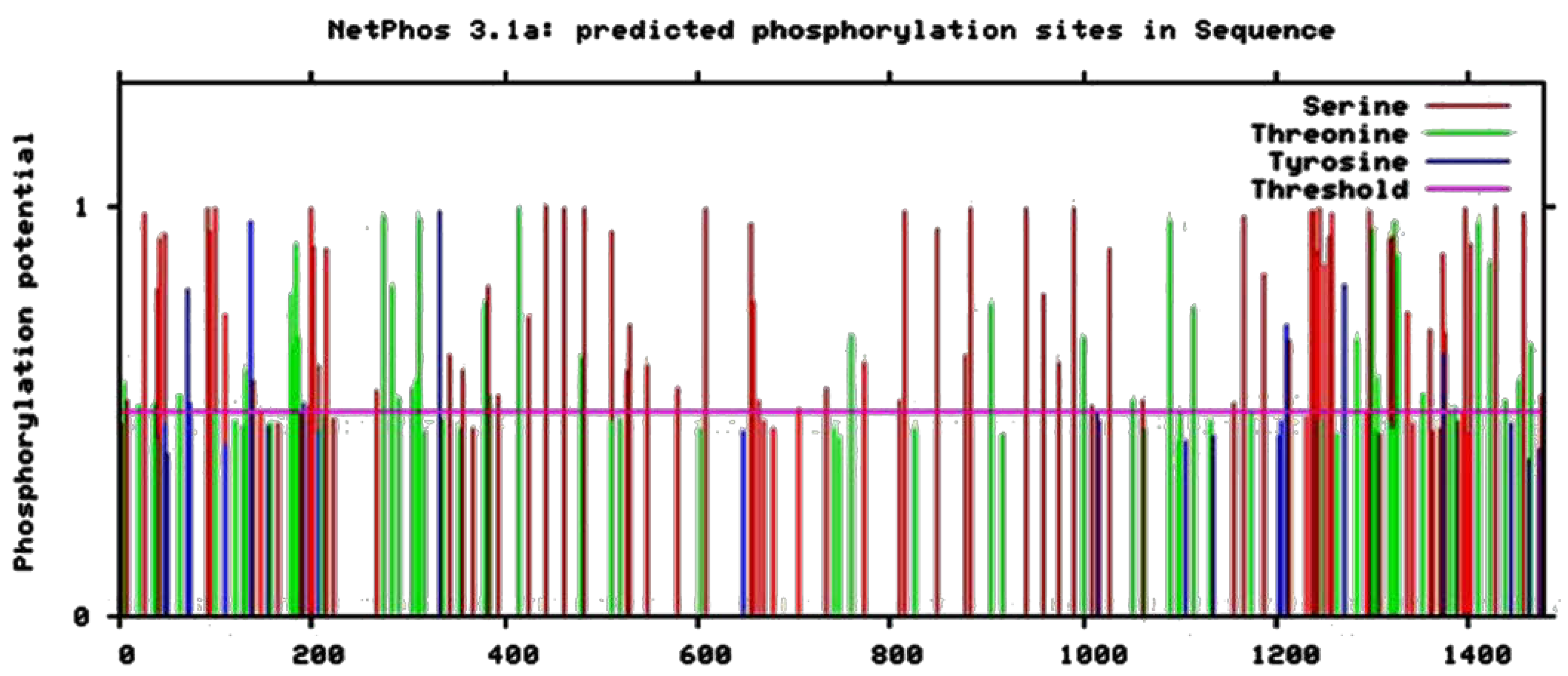
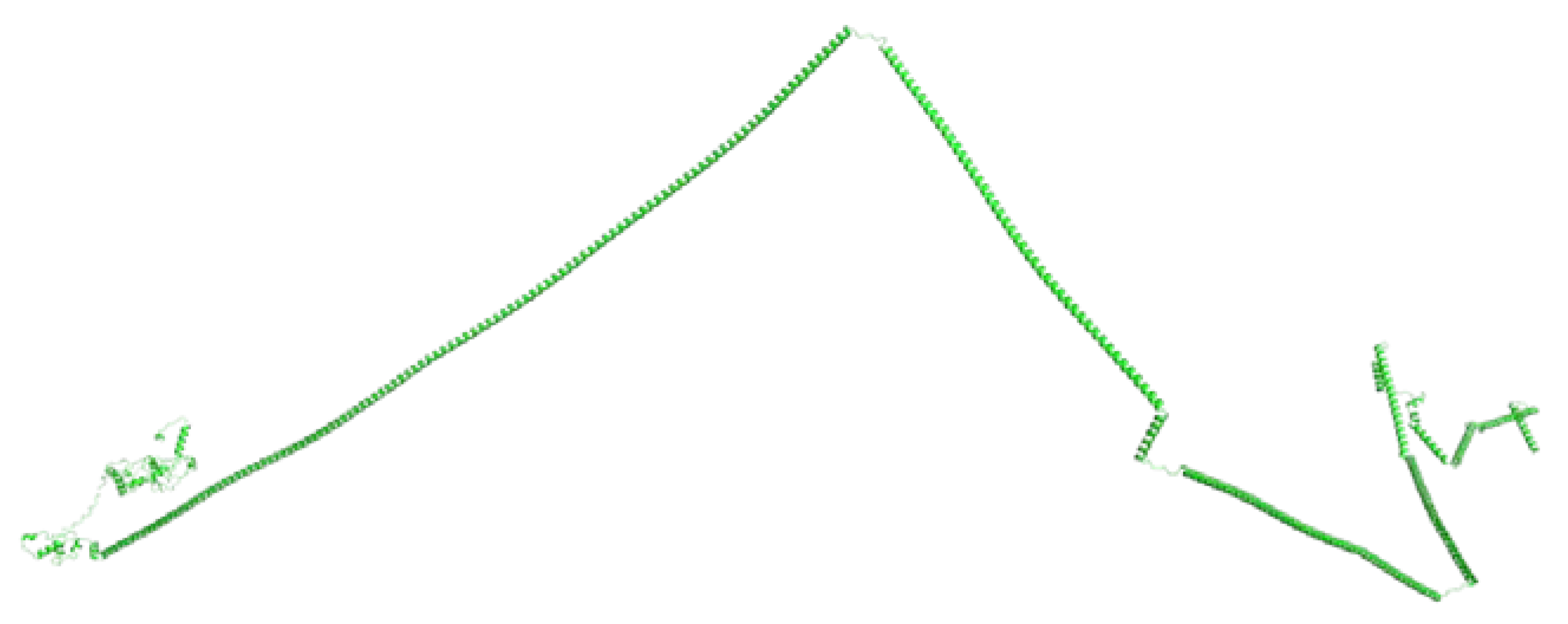
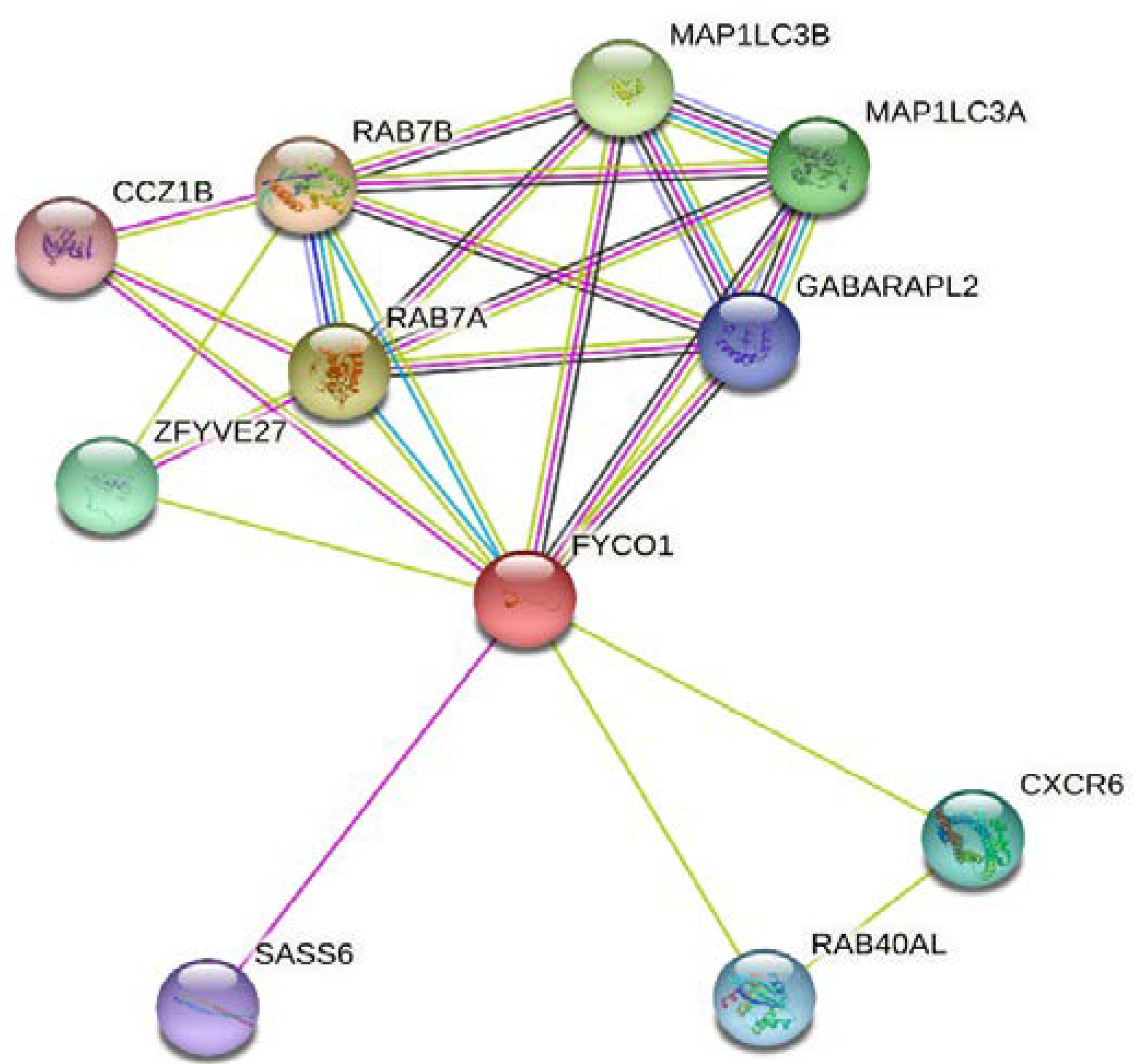

| Characteristic | Value/Symbol |
|---|---|
| Molecular weight | 166982.63 |
| Theoretical PI | 4.86 |
| Formula | C7173H11580N2086O2388S54 |
| Total number of atoms | 23281 |
| Estimated half-life | 30 h |
| Aliphatic index | 79.42 |
| Grand average of hydropathicity (GRAVY) | −0.737 |
| Instability index | 53.79 |
Disclaimer/Publisher’s Note: The statements, opinions and data contained in all publications are solely those of the individual author(s) and contributor(s) and not of MDPI and/or the editor(s). MDPI and/or the editor(s) disclaim responsibility for any injury to people or property resulting from any ideas, methods, instructions or products referred to in the content. |
© 2023 by the authors. Licensee MDPI, Basel, Switzerland. This article is an open access article distributed under the terms and conditions of the Creative Commons Attribution (CC BY) license (https://creativecommons.org/licenses/by/4.0/).
Share and Cite
Ullah, M.I.; Rehman, Z.; Dad, R.; Alsrhani, A.; Shakil, M.; Ghanem, H.B.; Alameen, A.A.M.; Elsadek, M.F.; Eltayeb, L.B.; Ullah, S.; et al. Identification and Functional Characterization of Mutation in FYCO1 in Families with Congenital Cataract. Life 2023, 13, 1788. https://doi.org/10.3390/life13081788
Ullah MI, Rehman Z, Dad R, Alsrhani A, Shakil M, Ghanem HB, Alameen AAM, Elsadek MF, Eltayeb LB, Ullah S, et al. Identification and Functional Characterization of Mutation in FYCO1 in Families with Congenital Cataract. Life. 2023; 13(8):1788. https://doi.org/10.3390/life13081788
Chicago/Turabian StyleUllah, Muhammad Ikram, Zaira Rehman, Rubina Dad, Abdullah Alsrhani, Muhammad Shakil, Heba Bassiony Ghanem, Ayman Ali Mohammed Alameen, Mohamed Farouk Elsadek, Lienda Bashier Eltayeb, Sajjad Ullah, and et al. 2023. "Identification and Functional Characterization of Mutation in FYCO1 in Families with Congenital Cataract" Life 13, no. 8: 1788. https://doi.org/10.3390/life13081788
APA StyleUllah, M. I., Rehman, Z., Dad, R., Alsrhani, A., Shakil, M., Ghanem, H. B., Alameen, A. A. M., Elsadek, M. F., Eltayeb, L. B., Ullah, S., & Atif, M. (2023). Identification and Functional Characterization of Mutation in FYCO1 in Families with Congenital Cataract. Life, 13(8), 1788. https://doi.org/10.3390/life13081788








